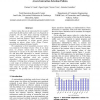Free Online Productivity Tools
i2Speak
i2Symbol
i2OCR
iTex2Img
iWeb2Print
iWeb2Shot
i2Type
iPdf2Split
iPdf2Merge
i2Bopomofo
i2Arabic
i2Style
i2Image
i2PDF
iLatex2Rtf
Sci2ools
74
Voted
IPPS
2006
IEEE
2006
IEEE
Empowering a helper cluster through data-width aware instruction selection policies
Narrow values that can be represented by less number of bits than the full machine width occur very frequently in programs. On the other hand, clustering mechanisms enable cost- and performance-effective scaling of processor back-end features. Those attributes can be combined synergistically to design special clusters operating on narrow values (a.k.a. Helper Cluster), potentially providing performance benefits. We complement a 32-bit monolithic processor with a low-complexity 8-bit Helper Cluster. Then, in our main focus, we propose various ideas to select suitable instructions to execute in the data-width based clusters. We add data-width information as another instruction steering decision metric and introduce new data-width based selection algorithms which also consider dependency, inter-cluster communication and load imbalance. Utilizing those techniques, the performance of a wide range of workloads are substantially increased; Helper Cluster achieves an average speedup of 11% fo...
8-bit Helper Cluster | Distributed And Parallel Computing | Helper Cluster | IPPS 2006 | Narrow Values |
| Added | 12 Jun 2010 |
| Updated | 12 Jun 2010 |
| Type | Conference |
| Year | 2006 |
| Where | IPPS |
| Authors | Osman S. Unsal, Oguz Ergin, Xavier Vera, Antonio González |
Comments (0)

